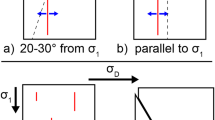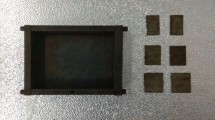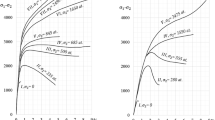Abstract
Fracture is a fundamental mechanism of material failure. Two basic types of brittle fractures are commonly observed in rock deformation experiments—extension (opening mode) fractures and shear fractures1,2. For nearly half a century it has been hypothesized that extension and shear fractures represent end-members of a continuous spectrum of brittle fracture types3,4,5,6. However, observations of transitional fractures that display both opening and shear modes (hybrids) in naturally deformed rock have often remained ambiguous, and a clear demonstration of hybrid fracture formation has not been provided by experiments4. Here we present the results of triaxial extension experiments on Carrara marble that show a continuous transition from extension fracture to shear fracture with an increase in compressive stress. Hybrid fractures form under mixed tensile and compressive stress states at acute angles to the maximum principal compressive stress. Fracture angles are greater than those observed for extension fractures and less than those observed for shear fractures. Fracture surfaces also display a progressive change from an extension to shear fracture morphology.
This is a preview of subscription content, access via your institution
Access options
Subscribe to this journal
Receive 51 print issues and online access
$199.00 per year
only $3.90 per issue
Buy this article
- Purchase on Springer Link
- Instant access to full article PDF
Prices may be subject to local taxes which are calculated during checkout



Similar content being viewed by others
References
Jaeger, J. C. & Cook, N. G. W. Fundamentals of Rock Mechanics (Chapman and Hall, London, 1979)
Paterson, M. S. Experimental Rock Deformation—The Brittle Field (Springer, Berlin, 1978)
Hancock, P. L. in Geology in the Real World—the Kingsley Dunham Volume (eds Nichol, I. & Nesbitt, R. W.) 155–164 (Institution of Mining and Metallurgy, London, 1986)
Engelder, T. Transitional-tensile fracture propagation: a status report. J. Struct. Geol. 21, 1049–1055 (1999)
Muehlberger, W. R. Conjugate joint sets of small dihedral angle. J. Geol. 69, 211–219 (1961)
Sibson, R. H. Brittle-failure controls on maximum sustainable overpressure in different tectonic regimes. Am. Assoc. Petrol. Geol. Bull. 87, 901–908 (2003)
Griggs, D. T. & Handin, J. W. Observations on fracture and a hypothesis of earthquakes. Geol. Soc. Am. Mem. 79, 347–364 (1960)
Hoskins, E. R. The failure of thick-walled hollow cylinders of isotropic rock. Int. J. Rock Mech. Min. Sci. 6, 99–125 (1969)
Handin, J. On the Coulomb-Mohr failure criterion. J. Geophys. Res. 74, 5343–5348 (1969)
Mogi, K. Effect of the intermediate principal stress on rock failure. J. Geophys. Res. 72, 5117–5131 (1967)
Leon, A. Über die Rolle des Trennbruches im Rahmen der Mohrschen Anstrengungshypothese. Bauingenieur 15, 318–321 (1934)
Nadai, A. Theory of Flow and Fracture of Solids (McGraw Hill, New York, 1934)
Griffith, A. A. Theory of rupture. Proc. Int. Congr. Appl. Mech. 1, 55–63 (1924)
McClintock, F. A. & Walsh, J. B. in Proc. 4th US Nat. Congr. Appl. Mech. Vol. II, 1015–1021 (Am. Soc. Mech. Eng., New York, 1962)
Murrell, S. A. F. The effect of triaxial stress systems on the strength of rocks at atmospheric temperatures. Geophys. J. R. Astron. Soc. 10, 231–281 (1965)
Murrell, S. A. F & Digby, P. J. The theory of brittle fracture initiation under triaxial stress conditions. I and II. Int. Geophys. J. R. Astron. Soc. 19, 309–334 and 499–512 (1970)
Brace, W. F. An extension of the Griffith theory of fracture to rocks. J. Geophys. Res. 65, 3477–3480 (1960)
Secor, D. T. Role of fluid pressure in jointing. Am. J. Sci. 263, 633–646 (1965)
Brace, W. F. in State of Stress in the Earth's Crust (ed. Judd, W. R.) 111–180 (American Elsevier, New York, 1964)
Schock, R. N. & Louis, H. Strain behavior of a granite and a greywacke sandstone in tension. J. Geophys. Res. 87, 7817–7823 (1982)
Pieri, M., Burlini, L., Kunze, K., Stretton, I. & Olgaard, D. Rheological and microstructural evolution of Carrara marble with high shear strain: results from high temperature torsion experiments. J. Struct. Geol. 23, 1393–1413 (2001)
Ramsey, J. M. Experimental Study of the Transition from Brittle Shear Fractures to Joints (Texas A&M Univ. Press, College Station, TX, 2003)
Neuber, H. Theory of Notch Stresses (McGraw-Hill, New York, 1937)
Handin, J., Friedman, M., Logan, J. M., Pattison, L. J. & Swolfs, H. S. in Flow and Fracture of Rocks (eds Heard, H. C., Borg, I. Y., Carter, N. L. & Raleigh, C. B.) 1–28 (AGU Geophys. Monogr. 16, American Geophysical Union, 1972)
Jaeger, J. C. & Hoskins, E. R. Stresses and failure in rings of rock loaded in diametral tension or compression. Br. J. Appl. Phys. 17, 685–692 (1966)
Engelder, T. The analysis of pinnate joints in the Mount Desert Island granite: implications for post-intrusion kinematics in the coastal volcanic belt, Maine. Geology 17, 564–567 (1989)
Reches, Z. & Lockner, D. Nucleation and growth of faults in brittle rocks. J. Geophys. Res. 99, 18159–18174 (1994)
Acknowledgements
We thank M. Finn, A. K. Kronenberg and J. S. Chester for discussions and suggestions, J. N. Magouirk and E. C. Powell for assistance in the laboratory, and J. S. Chester for reviews of the manuscript. This work was partially supported by US NSF.
Author information
Authors and Affiliations
Corresponding author
Ethics declarations
Competing interests
The authors declare that they have no competing financial interests.
Rights and permissions
About this article
Cite this article
Ramsey, J., Chester, F. Hybrid fracture and the transition from extension fracture to shear fracture. Nature 428, 63–66 (2004). https://doi.org/10.1038/nature02333
Received:
Accepted:
Issue Date:
DOI: https://doi.org/10.1038/nature02333
Comments
By submitting a comment you agree to abide by our Terms and Community Guidelines. If you find something abusive or that does not comply with our terms or guidelines please flag it as inappropriate.



